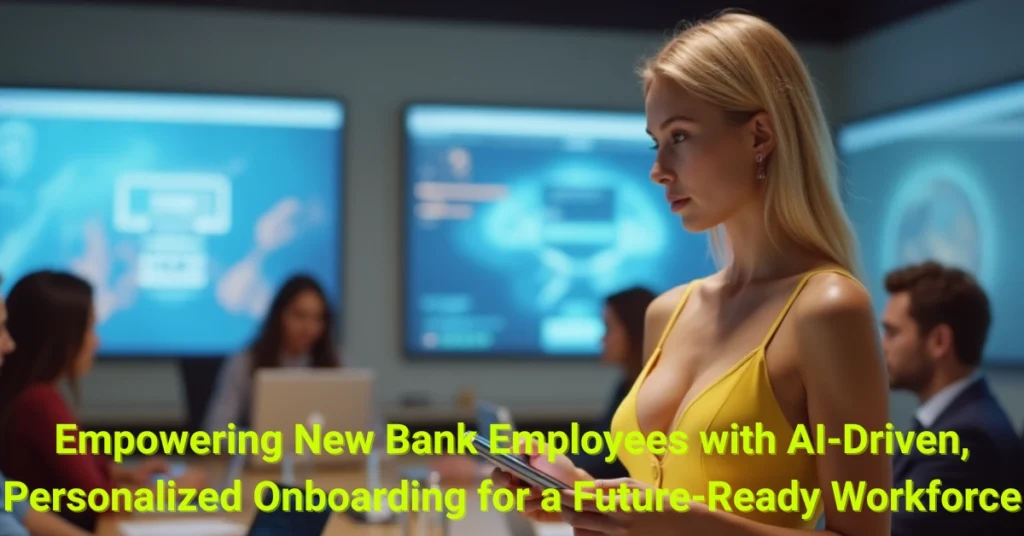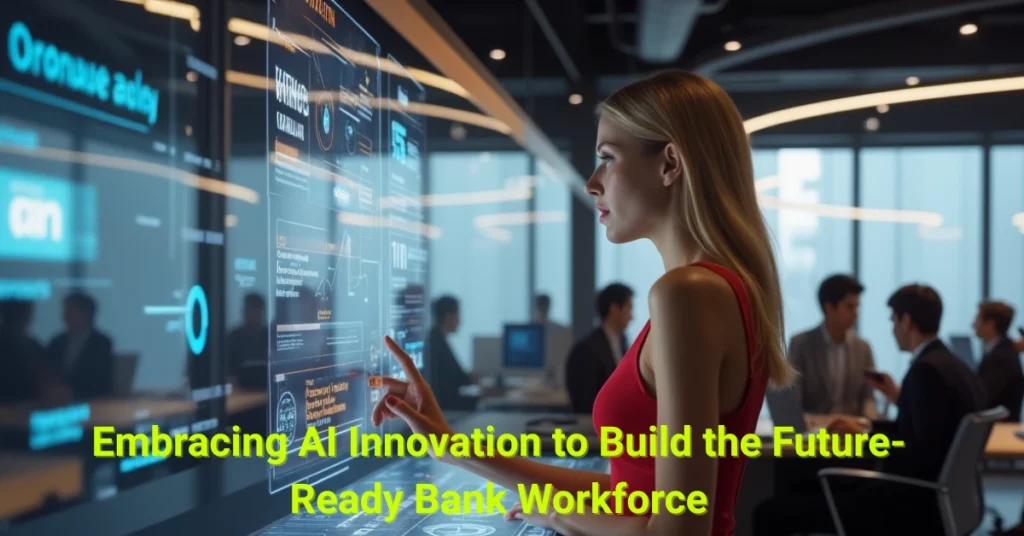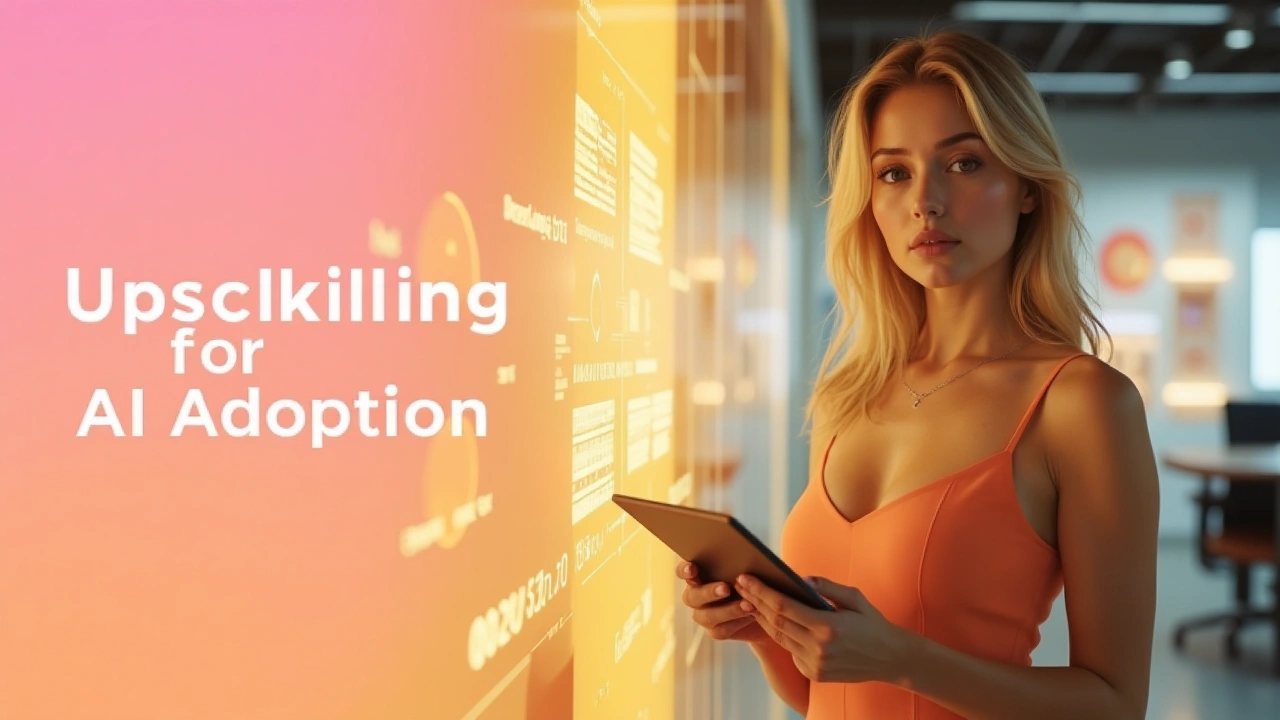Upskilling for AI Adoption: The AI Wave Hits Banking
In a world increasingly dominated by technological innovation, it is remarkable to see that some banks still operate with outdated systems, much like that one friend who continues to use a flip phone while the rest of us have embraced the versatility of smartphones. The reality, however, is that these banking institutions stand at a critical juncture, where the winds of artificial intelligence (AI) are transforming the landscape at an unprecedented rate. To keep pace, the industry must prioritize upskilling for AI adoption, focusing not only on advanced technologies but also on preparing a future-ready workforce.
As the banking sector undergoes digital transformation initiatives, the need for digital skills development is more pressing than ever. The shift towards automation and AI-driven innovation requires that banks invest in continuous learning culture, ensuring that their employees evolve alongside technology. This approach fosters tech-savvy employees who are equipped to thrive in a rapidly changing environment. Moreover, organizations must implement change management strategies to help their workforce embrace new roles and responsibilities that come with the integration of AI.

By emphasizing human-AI collaboration, banks can harness the strengths of both employees and automated systems. This collaborative ethos nurtures an agile workforce that can quickly adapt to new demands and challenges. Employee onboarding programs should incorporate AI training modules, focusing on reskilling for automation tools and cross-skilling in finance and other relevant sectors. Through personalized learning paths and virtual learning platforms, banks can ensure their personnel remain competitive and engaged.
In navigating this AI wave, banks have the opportunity to redesign banking jobs, making them not only more fulfilling but also oriented towards organizational resilience. By leveraging workforce analytics in banking, they can effectively identify areas for improvement, ultimately leading to enhanced operational efficiency and productivity. The future might seem daunting, but with the right strategies in place, banks can rise to the occasion and emerge stronger than ever.
Understanding Upskilling for AI Adoption
Upskilling for AI adoption refers to the process of enhancing employees’ knowledge and capabilities to effectively utilize artificial intelligence (AI) tools within their roles. In the context of banking, this means providing training and support to employees so they can seamlessly integrate AI applications into their daily functions, fostering human-AI collaboration. As banks undergo significant digital transformation initiatives, the importance of upskilling cannot be overstated. Financial institutions must equip their workforce with the necessary digital skills to harness the potential of AI-driven innovation.

Many banks are recognizing the critical need to lower resistance to change by implementing comprehensive employee onboarding programs that incorporate AI training modules. This proactive approach not only enhances the skills of tech-savvy employees but also cultivates a continuous learning culture essential for adapting to evolving market demands. For instance, offering cross-skilling opportunities in areas such as finance can help create a versatile and agile workforce capable of navigating the complexities of automation tools.
The implications of failing to upskill employees are significant. Without proper training and reskilling initiatives, banks risk losing competitive advantage and may struggle with organizational resilience. In an industry where workforce analytics in banking plays a pivotal role in decision-making, employees who are not well-versed in utilizing these advanced tools may hinder their organizations’ growth and efficiency.
Additionally, banks that neglect the importance of nurturing a future-ready workforce may face challenges in adopting cloud technology and implementing change management strategies, ultimately impacting their overall success. Therefore, investing in upskilling for AI adoption is not merely a trend but a strategic necessity for financial institutions looking to thrive in the coming years.
Key Areas of Digital Skills Development
As banks navigate the transformative landscape of AI adoption, a purposeful focus on digital skills development emerges as a priority. Central to this endeavor is fostering human-AI collaboration, which involves not only understanding AI’s capabilities but also comprehending its limitations. Employees equipped with strong digital skills can effectively work alongside AI systems, enhancing productivity and decision-making processes. This alignment is essential for building a future-ready workforce that thrives in an increasingly automated environment.

Workforce agility plays a crucial role in this upskilling initiative. Banks are investing in reskilling for automation tools to ensure that employees can adapt swiftly to evolving technologies and processes. By promoting a continuous learning culture, organizations can encourage tech-savvy employees to embrace change rather than resist it. This adaptive mindset is vital for maintaining competitive edge amid digital transformation initiatives and rapid shifts in customer expectations.
In terms of specific digital skills, data analysis has emerged as a cornerstone competency. With the increasing reliance on data to drive decisions and personalize customer experiences, banks are emphasizing the need for employees to interpret and derive insights from data sets. Similarly, cybersecurity awareness is paramount; as financial institutions face heightened risks from cyber threats, employees well-versed in security protocols are crucial for protecting sensitive information. Additionally, customer relationship management is evolving with the integration of AI tools, necessitating employees who are skilled in leveraging technology to enhance customer interactions.
Each of these digital skills—data analysis, cybersecurity, and customer relationship management—facilitates AI-driven innovation, enabling banks to redesign jobs and create more value for their clients. By prioritizing these areas in their employee onboarding programs and AI training modules, banks can ensure their workforce is not only equipped for the future but also resilient in the face of change.
Transforming Employee Onboarding Programs
In the rapidly evolving banking sector, organizations are recognizing the critical need to revamp their employee onboarding programs to prepare for a future characterized by AI adoption and digital transformation initiatives. This transition is essential for cultivating a workforce capable of harnessing AI-driven innovation and maintaining a competitive edge. By implementing modern onboarding strategies that emphasize AI training modules and personalized learning paths, banks can create tech-savvy employees ready to thrive amidst the challenges posed by a digital landscape.
Many banks have begun integrating these components into their onboarding processes, leading to notable improvements in workforce agility. For instance, instead of the traditional cookie-cutter training sessions that can feel monotonous, some banks now leverage virtual learning platforms. These platforms provide a dynamic, engaging environment where new hires can explore cloud technology training or delve into change management strategies. One bank humorously recalled how a group of new employees initially struggled with the AI tools, only to later marvel at how a simple interactive game introduced during training enhanced their understanding. Such anecdotes highlight the efficiency of modernized onboarding efforts.
Moreover, personalized learning paths allow new recruits to focus on relevant topics that resonate with their specific roles, whether in finance or customer service. This targeted approach not only accelerates adaptation but also nurtures a continuous learning culture, essential for sustaining a future-ready workforce. Employees can now move through customized training modules at their own pace, ensuring they grasp the necessary skills for reskilling for automation tools and cross-skilling in finance.
Ultimately, the transformation of employee onboarding programs in banks showcases a proactive approach to addressing the challenges of AI integration, paving the way for enhanced organizational resilience and a workforce that is inherently ready for what lies ahead.
Engaging with Continuous Learning Culture

In the fast-paced world of banking, fostering a continuous learning culture is essential for maintaining a competitive edge, particularly as the industry increasingly embraces AI. This concept not only promotes innovation and resilience within organizations but also empowers employees to become proactive in their professional development. However, the challenge lies in integrating ongoing education into already busy work schedules. Imagine the common scenario of an employee attempting to squeeze an online course into their lunch break, only to be interrupted by urgent emails, meetings, and the delightful unpredictability of technology. It’s a comedic struggle that reflects the need for a supportive learning environment.
Banks can effectively cultivate a continuous learning culture by implementing a variety of strategies. The adoption of virtual learning platforms allows employees to engage with training at their convenience, creating personalized learning paths that cater to individual needs. These platforms can include AI training modules specifically designed to enhance digital skills development, ensuring that employees are ready to handle AI-driven innovations in their roles.
Additionally, interactive workshops and seminars can be organized, encouraging cross-skilling in finance and reskilling for automation tools. This collaborative approach not only broadens employees’ knowledge but also reinforces the significance of human-AI collaboration.
Moreover, structured employee onboarding programs tailored for the evolving landscape of banking can lay a strong foundation for this continuous learning culture. By incorporating training on change management strategies and workforce analytics in banking, new hires can feel equipped to manage their roles effectively.
As banks embark on digital transformation initiatives, a commitment to developing tech-savvy employees will drive workforce agility. Ultimately, creating a culture that values continuous learning will ensure that organizations are not only prepared for the current technological advancements but are also resilient enough to adapt to future challenges.
Change Management Strategies for a Smooth Transition
The journey toward AI adoption in the banking sector can be likened to navigating a ship through turbulent waters. Just as a captain must carefully steer their vessel and communicate with the crew, banks must implement effective change management strategies to guide their employees through the challenges of workforce transformation. In this context, addressing the emotional and practical aspects of change is crucial to promote upskilling for AI adoption.
Effective communication serves as the compass in this analogy, ensuring that employees are well-informed about the changes taking place. Banks can foster an atmosphere of openness by communicating the rationale behind AI integration, the benefits it brings, and how it enhances daily operations. This level of transparency eases concerns and mitigates resistance, leading to a smoother transition. Furthermore, ensuring that leadership actively supports and participates in the change process inspires confidence among employees. Their visible commitment serves as a motivational beacon, reassuring teams that digital skills development is not only prioritized but also essential for the organization’s future.
Involving employees in the transformation process can bolster their sense of ownership, allowing them to participate in decision-making and suggest improvements. Implementing employee onboarding programs focused on AI training modules ensures that the workforce is well-equipped to embrace new technologies. Moreover, fostering a culture of continuous learning cultivates tech-savvy employees, enabling them to engage with AI-driven innovation more effectively.
Resistance can further be alleviated through personalized learning paths and support systems that cater to individual needs. By offering virtual learning platforms, institutions can facilitate reskilling for automation tools, ensuring employees adapt seamlessly to their new responsibilities. Ultimately, deploying change management strategies tailored to the unique challenges of banking promotes organizational resilience and workforce agility, empowering banks to thrive in a digitally transforming landscape.
The Role of Workforce Analytics in Banking
In the rapidly changing landscape of banking, workforce analytics has emerged as a key component in shaping successful upskilling initiatives for AI adoption. By leveraging data-driven decision-making, banks are equipped to comprehensively understand the skill gaps and training needs of their employees. This understanding not only aligns with the institution’s business goals but also ensures that the workforce remains agile and prepared for the digital transformation initiatives ahead.
For instance, banks can utilize workforce analytics to analyze employee performance metrics, engagement levels, and training effectiveness. This rich dataset allows for the identification of specific areas where employees may require digital skills development, particularly in areas like cloud technology training or AI training modules. An example could be a humorous scenario where a bank employee struggles to understand AI chatbots, resulting in a comical miscommunication with a customer. By analyzing the data, banks can quickly identify this common skill gap and develop targeted training programs for tech-savvy employees.
Moreover, workforce analytics can guide the creation of personalized learning paths, tailored to meet the unique needs of each employee. This practice fosters a culture of continuous learning and promotes human-AI collaboration, elements that are crucial for building a future-ready workforce. Additionally, monitoring the impact of reskilling for automation tools can inform change management strategies, making it easier to adapt employee onboarding programs accordingly.
Ultimately, the implementation of workforce analytics in banking not only enhances training and development programs but also bolsters organizational resilience. By focusing on AI-driven innovation, banks can ensure their employees receive ongoing support, maximizing the effectiveness of cross-skilling in finance and other critical areas. As they embrace data-led insights, financial institutions are positioning themselves adeptly for a transformative era, ensuring their workforce is well-equipped to navigate the challenges and opportunities in the coming years.
Case Studies: Success Stories in Upskilling

In the rapidly evolving landscape of banking, several institutions have made remarkable strides in upskilling for AI adoption, providing insightful case studies for others to emulate. One notable example is Bank of America, which implemented comprehensive AI training modules for its workforce. The initiative not only focused on enhancing digital skills development but also prioritized cross-skilling in finance. Employees were encouraged to engage in continuous learning culture through virtual learning platforms that offered personalized learning paths. This strategic approach resulted in a significant increase in employee productivity and engagement, effectively transforming them into tech-savvy employees equipped for the AI-driven innovation that characterizes modern banking.
Another inspiring story comes from JPMorgan Chase, which launched an extensive digital transformation initiative aimed at leveraging workforce analytics in banking. Their change management strategies included robust employee onboarding programs that emphasized the importance of human-AI collaboration. By integrating reskilling for automation tools into their training regime, the bank cultivated organizational resilience, enabling employees to adapt seamlessly to new technologies. The bank reported a substantial enhancement in workforce agility, leading to faster turnaround times in customer service and more efficient operations.
Lastly, DBS Bank stands out for its commitment to a holistic approach towards upskilling for AI adoption. Through a blend of cloud technology training and leadership development programs, the bank not only focused on technical skills but also nurtured a culture of innovation among its workforce. The successful integration of AI into their operations not only improved performance metrics but also fostered a workplace atmosphere where employees felt empowered to contribute ideas, thereby reinforcing a learning-centric environment. These success stories serve as valuable lessons for other institutions aiming to navigate their own workforce transformation, demonstrating that with the right strategies, any bank can thrive in the age of AI.
Embracing the Future of Banking

As we look toward the future of banking, it is evident that the evolution stemming from AI adoption necessitates a comprehensive approach to workforce transformation. The implications of upskilling for AI adoption extend far beyond mere technical training; they encompass the development of a continuous learning culture that supports digital skills development across all levels of the organization. This transformation will enable banks to not only enhance workforce agility but also foster employee engagement through effective change management strategies.
The integration of innovative AI training modules, designed to meet the unique needs of different departments, has the potential to reshape roles within the banking sector. For instance, cross-skilling in finance enables employees to adapt to automation tools, ensuring they remain relevant in an increasingly tech-driven environment. Furthermore, personalized learning paths tailored to individual career aspirations can significantly bolster employee retention rates, while cloud technology training prepares staff for the inevitable shifts in digital transformation initiatives.
In reflecting on these changes, it is crucial for both employees and management to engage in open dialogues about their experiences with technology and workplace adaptations. As organizations embrace AI-driven innovation, fostering a skilled and tech-savvy workforce becomes paramount. By prioritizing employee onboarding programs and investing in workforce analytics in banking, institutions can create a future-ready workforce equipped to tackle the challenges ahead.
As we move forward, we invite you to share your thoughts in the comments section. Have you experienced upskilling initiatives at your bank? What improvements do you believe can be made to enhance your own upskilling journey? Your insights are valuable as we collectively navigate the path of workforce transformation.
Umbrella Insurance Policies: The Protection That Rains on Your Parades
Loans vs. Lines of Credit: What U.S. Borrowers Need to Know in 2025.








































